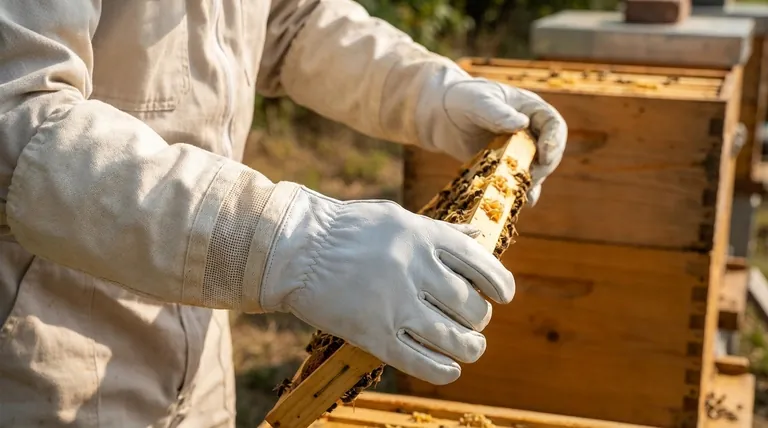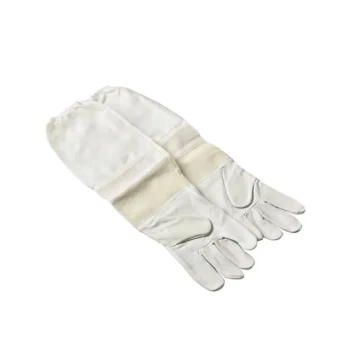The ideal fit for beekeeping gloves is snug, but not tight. This balance is critical because it allows you to feel and manipulate hive components with precision, much like a second skin, while still providing a protective barrier against stings. If the gloves are too loose, you lose dexterity; if they are too tight, they restrict movement and can be uncomfortable.
The core challenge in selecting beekeeping gloves is finding the perfect equilibrium between protection and dexterity. The right fit doesn't just prevent stings—it enables the delicate, confident movements required for effective hive management.

Why a Proper Fit is Non-Negotiable
A poorly fitting glove is more than an inconvenience; it's a liability. It compromises your ability to work efficiently and, more importantly, safely.
Maximizing Dexterity for Hive Work
A snug fit gives you the tactile feedback necessary for intricate tasks. You need to be able to gently lift frames, handle your hive tool with precision, and feel for the queen cage without fumbling.
Excess material at the fingertips of a loose glove will catch on hive components, leading to clumsy movements that can agitate the bees.
Preventing Unwanted Entry
Bees are opportunistic and will exploit any gap in your protective gear. Gloves that are snug around the wrist and arm prevent bees from crawling inside.
This is why most beekeeping gloves extend up the arm and are designed to be worn under the sleeve of your bee suit or jacket, creating a secure overlap.
Ensuring Beekeeper Confidence
Working with thousands of bees requires a calm and steady hand. The confidence that comes from knowing you are well-protected allows you to move deliberately and gently.
Ill-fitting gloves can be a constant distraction, pulling your focus away from the bees and onto your own discomfort or insecurity.
Understanding the Trade-offs: Glove Materials
The material of your glove is just as important as the fit. Each type offers a different balance between sting resistance and flexibility.
Leather Gloves: Maximum Protection
Traditional cowhide leather gloves offer the thickest barrier against stings. They are highly durable and provide excellent protection for your hands and arms.
However, this thickness comes at the cost of dexterity. The stiffness of new leather can make delicate tasks more challenging.
Goatskin & Nitrile-Coated: The Balanced Approach
Goatskin is a popular choice because it is thinner and more flexible than cowhide while still offering reliable sting resistance.
These gloves provide a good middle ground, allowing for greater control and sensitivity when handling frames and equipment. Nitrile-coated gloves offer a similar balance.
Canvas Gloves: Highest Dexterity
For tasks requiring the utmost precision, some beekeepers opt for thin canvas gloves. These offer the highest level of dexterity.
The trade-off is significantly reduced sting protection, making them more suitable for experienced beekeepers working with gentle colonies.
Making the Right Choice for Your Goal
Before you buy, always try on different sizes and materials. Make a fist and manipulate a small object to assess how well you can move your fingers without pinching or excessive looseness.
- If your primary focus is maximum protection and confidence as a new beekeeper: Choose thicker leather gloves that fit snugly, and accept the initial reduction in dexterity as you learn.
- If your primary focus is balancing protection with flexibility for routine inspections: Goatskin gloves are the most effective all-around choice for most beekeepers.
- If your primary focus is performing intricate tasks like queen marking: Consider nitrile-coated or even thin canvas gloves, but understand the increased risk of stings.
Ultimately, the right glove is the one that empowers you to be a calm, confident, and effective beekeeper.
Summary Table:
| Glove Material | Protection Level | Dexterity Level | Best For |
|---|---|---|---|
| Cowhide Leather | Maximum | Lower | New beekeepers prioritizing safety |
| Goatskin / Nitrile | Balanced | High | Routine inspections for most beekeepers |
| Canvas | Lower | Maximum | Experienced beekeepers doing intricate tasks |
Equip your apiary with gloves that offer the perfect fit. HONESTBEE supplies high-quality beekeeping gloves and protective gear to commercial apiaries and beekeeping equipment distributors. Our wholesale-focused operations ensure you get durable, well-fitting equipment that protects your team and enhances productivity. Contact HONESTBEE today to discuss your needs and request a wholesale catalog!
Visual Guide

Related Products
- Goatskin Leather Beekeeper Gloves with Vent Long Sleeve for Beekeeping Honey Bee Sting Proof Protection
- Cotton Beekeeping Suit and Round Hat with Veil Bee Keeper Protective Gear
- Mesh Ventilated 3 Layer Goatskin Beekeepers Gloves for Beekeeping
- Economy Polyester Beekeeping Jacket with Veil and Hat
- Beekeeping Jacket with Hood and Veil for Beekeepers
People Also Ask
- How do beekeeping gloves help in maintaining hygiene? Essential for Hive Biosecurity
- What are the features of beekeeping gloves? Balancing Protection & Dexterity for Your Hives
- What should be considered when selecting beekeeping gloves? Find the Perfect Fit for Safety & Dexterity
- Why is it important to have gloves available even if not always worn? Essential Risk Management for Beekeepers
- What should beginner beekeepers consider when choosing beekeeping gloves? Balance Protection and Dexterity for Success



















